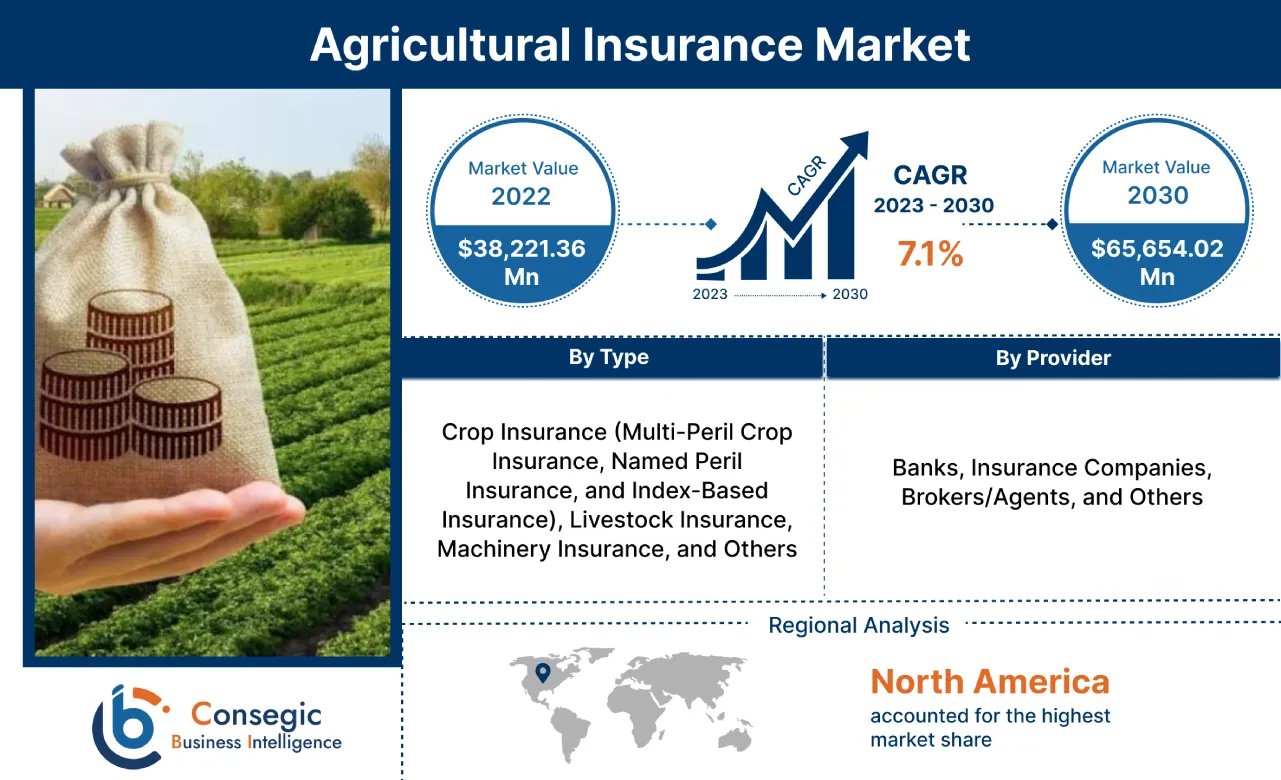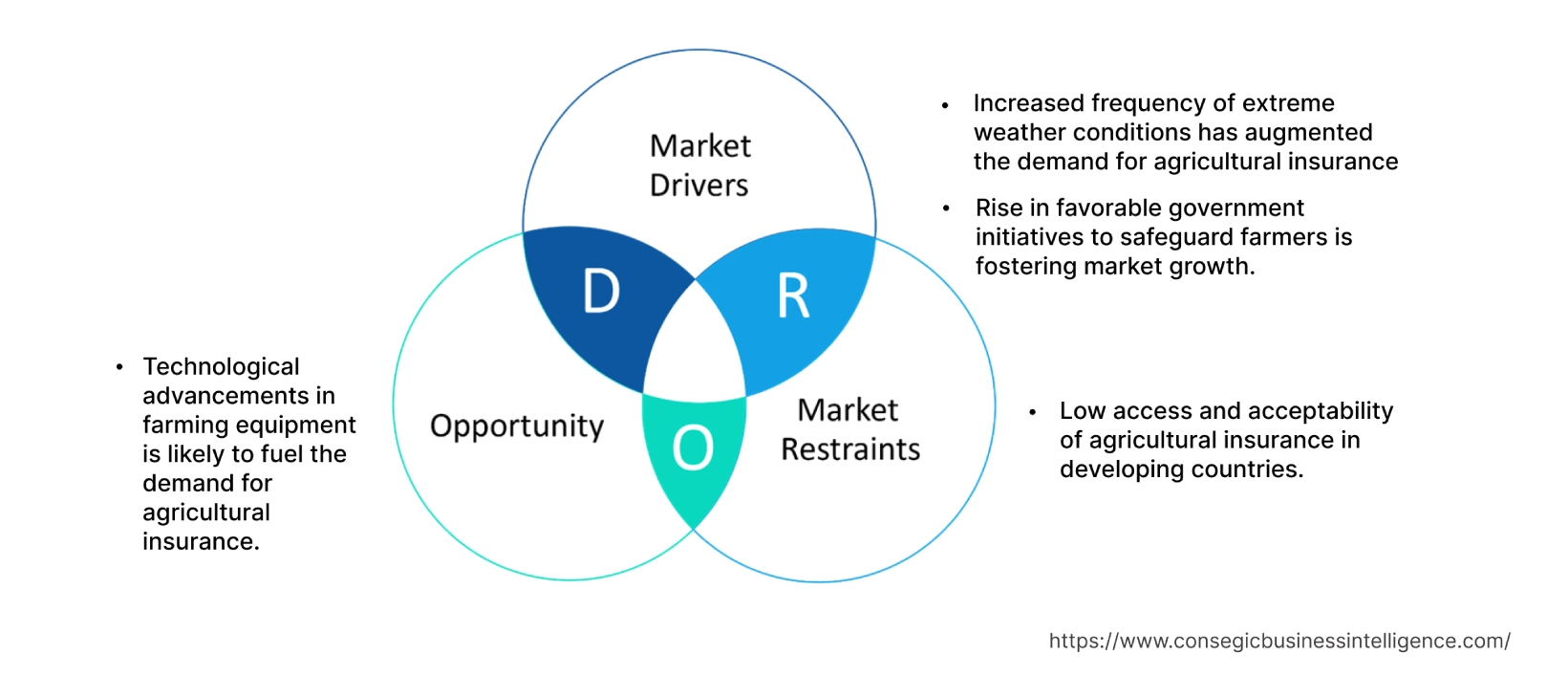- Summary
- Table Of Content
- Methodology
Agricultural Insurance Market Size :
Consegic Business Intelligence analyzes that the Agricultural Insurance Market size is growing with a CAGR of 7.1% during the forecast period (2023-2030), and the market is projected to be valued at USD 65,654.02 Million by 2030 from USD 38,221.36 Million in 2022.
Agricultural Insurance Market Scope & Overview:
Agricultural insurance is specifically designed and developed on the scientific basis and sound insurance principles to address the diverse needs of farmers. It is a type of insurance coverage mitigating the risks associated with agricultural production. This type of insurance provides financial compensation to farmers in the event of crop failure, damage to livestock, loss of income, or other agricultural-related losses.
The primary objective of agricultural insurance is to provide financial security and stability and security to farmers, helping them manage risks, protect their investments, and sustain their livelihoods. In addition, agriculture insurance promotes sustainable agricultural practices, supporting food production, and ensuring the stability of rural economies.
Agricultural Insurance Market Insights :
Key Drivers :
Increased frequency of extreme weather conditions has augmented the demand for agricultural insurance
Extreme weather conditions such as hurricanes, droughts, floods, and wildfires can have devastating effects on agricultural production. These events are likely to cause damage or destroy crops, infrastructure, or livestock, resulting in significant losses for farmers and agricultural businesses. As a result, agricultural insurance provides a safety net for farmers by offering cover against various risks associated with weather-related events. Another influencing factor is the increasing rates of droughts globally. For instance, according to the data reported by World Economic Forum, more than 43% of the U.S. experienced drought in July 2022. In addition to this, according to the statistics published by NOAA National Centers for Environmental Information, in the U.S., crop failures and other economic losses due to drought have totaled USD 249 Billion since 1980. Thus, the aforementioned factors are contributing to extreme weather conditions, in turn propelling the agricultural insurance market growth.
Rise in favorable government initiatives to safeguard farmers is fostering market growth
Governments often provide subsidies to make agriculture insurance more affordable to farmers. These financial incentives reduce the cost of insurance premiums, making them more affordable to farmers and businesses. By alleviating the financial burden, the government encourages farmers to obtain insurance coverage, thereby boosting the demand for agricultural insurance. Hence, the market growth is attributed to the introduction of supportive policies aimed at the agricultural sector. For instance, government schemes such as National Agricultural Insurance Scheme (NAIS), Pilot Modified National Agricultural Insurance Scheme (MNAIS), Prime Minister's Crop Insurance Scheme, and others in India are significantly contributing to the increasing demand for agriculture insurance.
Key Restraints :
Low access and acceptability of agricultural insurance in developing countries
Lack of awareness about agricultural insurance and unavailability of insurance products in some regions are some of the key factors restricting the agriculture insurance market growth. In many developing countries, farmers have limited awareness and understanding of insurance products and their benefits. Additionally, the limited availability of insurance services in remote rural areas is another significant factor contributing to low demand for agricultural insurance, further deterring market growth.
Future Opportunities :
Technological advancements in farming equipment is likely to fuel the demand for agricultural insurance
Technological advancements such as precision agriculture, autonomous machinery, and advanced sensors are revolutionizing farming practices. Farmers are increasingly adopting these technologies to improve productivity, reduce costs, and enhance efficiency. However, the high costs of these advanced farming technologies is a prominent factor propelling the demand for agricultural insurance. In addition to this, the increasing investment in farming equipment is expected to register a high demand for insurance coverage to protect against potential losses. As a result, the aforementioned factors are anticipated to enhance market growth during the forecast period.
Agricultural Insurance Market Report Insights :
| Report Attributes | Report Details |
| Study Timeline | 2017-2030 |
| Market Size in 2030 | USD 65,654.02 Million |
| CAGR (2023-2030) | 7.1% |
| By Type | Crop Insurance (Multi-Peril Crop Insurance, Named Peril Insurance, and Index-Based Insurance), Livestock Insurance, Machinery Insurance, and Others |
| By Provider | Banks, Insurance Companies, Brokers/Agents, and Others |
| By Region | North America, Europe, Asia-Pacific, Latin America, and Middle East & Africa |
| Key Players | Great American Insurance Company, Chubb, QBE Insurance (Australia) Ltd., Himalayan Everest Insurance CO.LTD., Agriculture Insurance Company of India Limited, Munich Re, Zurich American Insurance Company, Asian Development Bank, HUB International Limited, AXA SA, American Agricultural Insurance Company, AgroBrasil, and Haughn & Associates |
Agricultural Insurance Market Segmental Analysis :
By Type :
The type segment is categorized into crop insurance, livestock insurance, machinery insurance, and others. In 2022, the crop insurance segment accounted for the highest market share of 38.50% and is also anticipated to grow at the fastest CAGR over the forecast period. The crop insurance segment is further bifurcated into multi-peril crop insurance, named peril insurance, and index-based insurance. The multi-peril crop insurance holds the highest market share whereas index-based insurance is expected to grow at the fastest CAGR in the following years. The growth of the segment is driven by several factors including climate change and extreme weather events, rising cost of fertilizers, and increasing crop production owing to the growing food demand among others. Furthermore, according to the National Crop Insurance Services, in 2022, more than 490 million acres of farmland in the U.S. were protected through the Federal Crop Insurance Program. Hence, the increasing adoption of crop insurance among farmers is anticipated to surge the market growth in the following years.
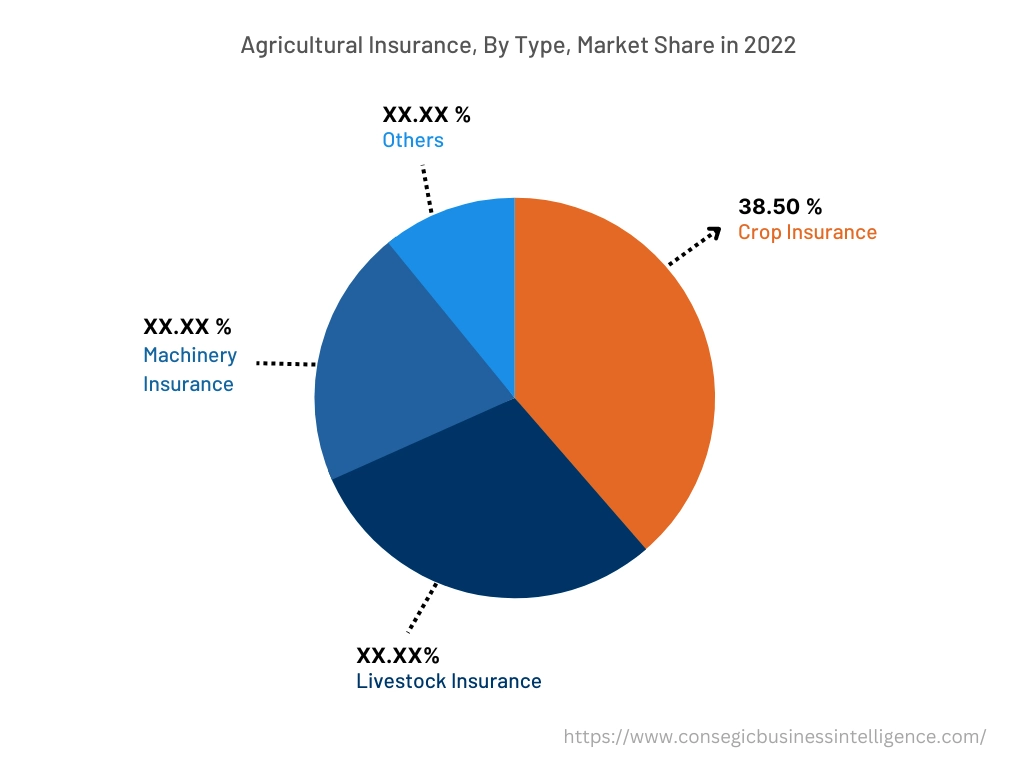
By Provider :
The provider segment is categorized into banks, insurance companies, brokers/agents, and others. In 2022, the insurance companies segment accounted for the highest market share in the overall agricultural insurance market. Insurance companies specialize in risk assessment, underwriting, and claims management. Additionally, these companies also provide additional value such as risk management and advisory services. Furthermore, the prevalence of market players such as Haughn & Associates, Great American Insurance Company, and QBE Insurance (Australia) Ltd., among others is another influencing factor accelerating the agricultural insurance market growth.
However, the banks segment is anticipated to grow at the fastest CAGR during the forecast period. Banks offer premium financial services, allowing farmers to pay their insurance premiums in installments rather than lump sum. This can be beneficial for farmers to secure the necessary insurance coverage without straining their immediate finances. As a result, these comprehensive financial solutions are likely to spur the demand for agricultural insurance and create lucrative opportunities for banks in the forecast year.
By Region :
The regional segment includes North America, Europe, Asia Pacific, Middle East and Africa, and Latin America.
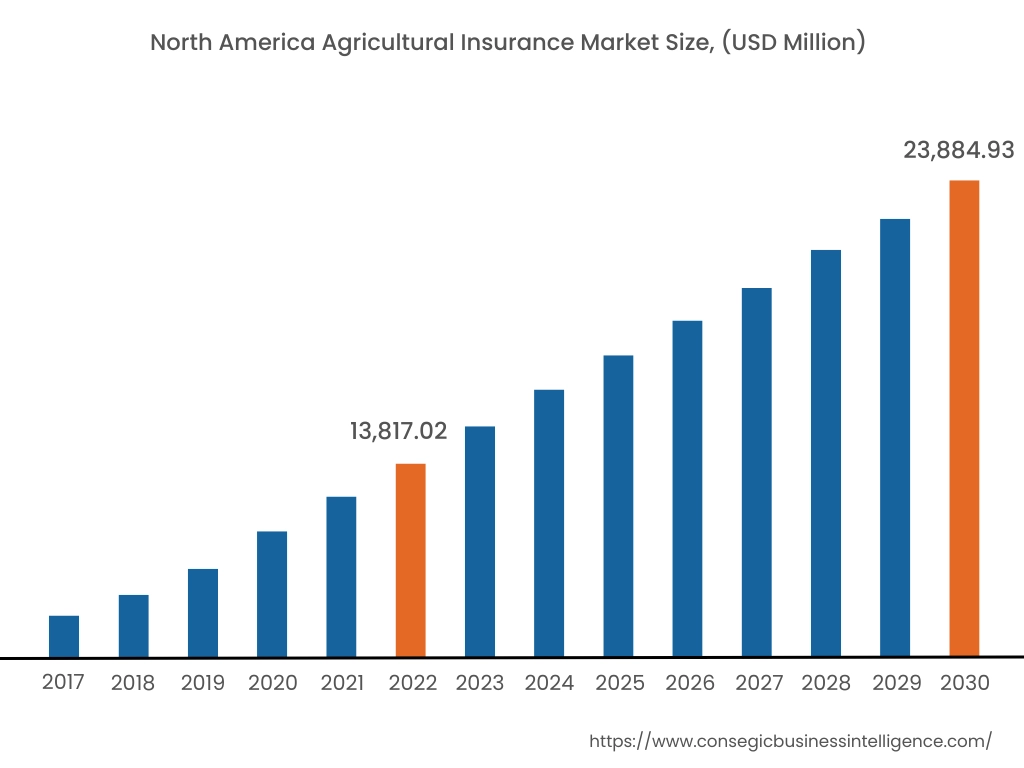
In 2022, North America accounted for the highest market share of 36.15% and was valued at USD 13,817.02 million, and is expected to reach USD 23,884.93 million in 2030. In the North American region, the U.S. accounted for the highest market share of 66.50% during the base year 2022 owing to the rapid change in climatic conditions, technological advancements in farming equipment, and an increase in adoption of sustainable farming practices. Moreover, according to the National Association of Insurance Commissioners, in 2021, over USD 14 million in premiums were written for multiple-peril crop insurance.
Moreover, Asia Pacific is expected to grow at the fastest CAGR of 8.1% during the forecast period due to the increase in awareness regarding the benefits of agricultural insurance. The growth of the segment is also attributed to the prevalence of natural disasters such as floods, droughts, and earthquakes. These events can cause severe damage to crops and livestock. For instance, according to the report published by the World Meteorological Organization (WMO), in 2021, there were a total of more than 100 natural hazard events in Asia, of which 80% were flood and storm events. In addition, reduced rainfall during the wet season affected water availability for the crops in 2021, which limited the availability of food in comparison to other years. As a result, the aforementioned factors will aid to surge the demand for agricultural insurance during the forecast period.
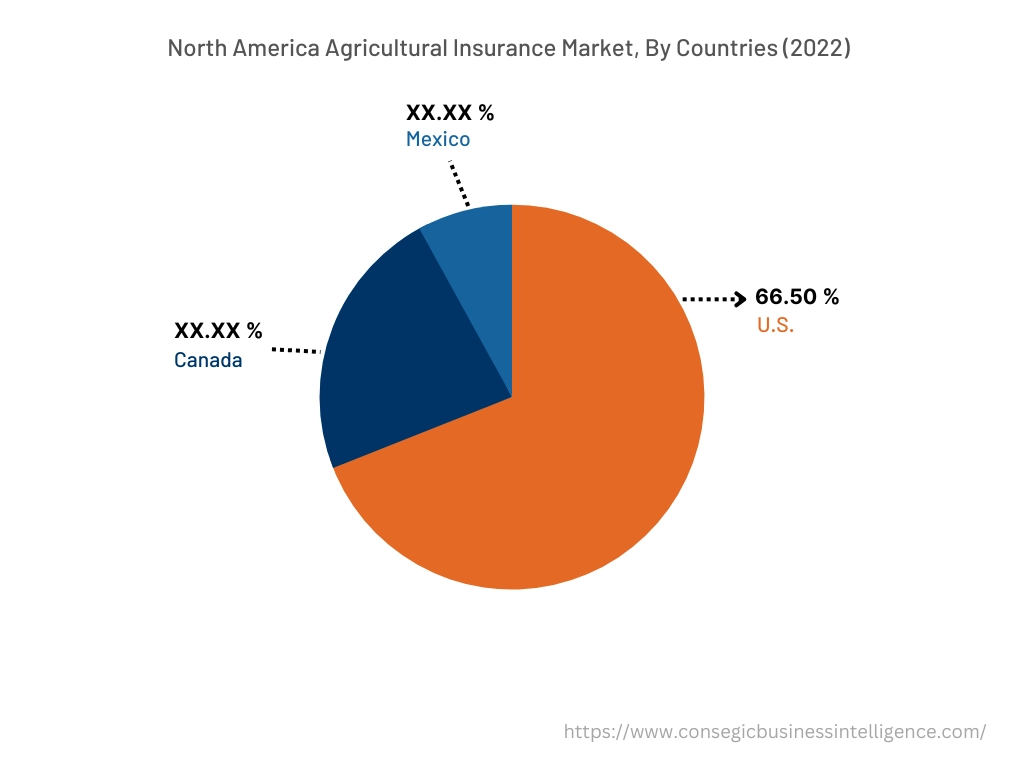
Top Key Players & Market Share Insights :
The agricultural insurance market is highly competitive, with several large players and numerous small and medium-sized enterprises. These companies have strong research and development capabilities and a strong presence in the market through their extensive product portfolios and distribution networks. The market is characterized by intense competition, with companies focusing on expanding their product offerings and increasing their market share through mergers, acquisitions, and partnerships. The key players in the market include-
- Great American Insurance Company
- Chubb
- HUB International Limited
- AXA SA
- American Agricultural Insurance Company
- AgroBrasil
- Haughn & Associates
- QBE Insurance (Australia) Ltd.
- Himalayan Everest Insurance CO.LTD.
- Agricultural Insurance Company of India Limited
- Munich Re
- Zurich American Insurance Company
- Asian Development Bank
Recent Industry Developments :
- In July 2023, American Financial Group, Inc. (AFG), has completed the purchase of Crop Risk Services (CRS) from American International Group, Inc. (AIG).
- In March 2023, Hub International acquired AG Direct Hail Insurance Ltd., a crop hail insurance provider.
Key Questions Answered in the Report
What was the market size of the agricultural insurance market in 2022? +
In 2022, the market size of agricultural insurance was USD 38,221.36 million
What will be the potential market valuation for the agricultural insurance market by 2030? +
In 2030, the market size of agricultural insurance is expected to reach USD 65,654.02 million.
What are the key factors driving the growth of the agricultural insurance market? +
The rise in favorable government initiatives to safeguard farmers is fostering market growth.
What is the dominant segment in the agricultural insurance market by type? +
In 2022, the crop insurance segment accounted for the highest market share in the overall agricultural insurance market.
Based on current market trends and future predictions, which geographical region will have the fastest impact on the agricultural insurance market's growth in the coming years? +
Asia Pacific is expected to be the fastest-growing region in the market during the forecast period.
